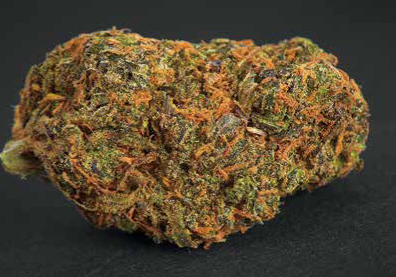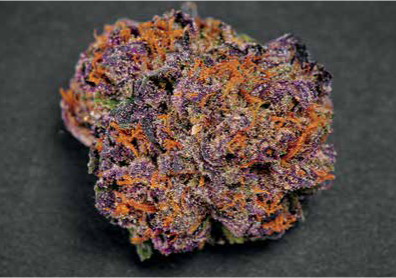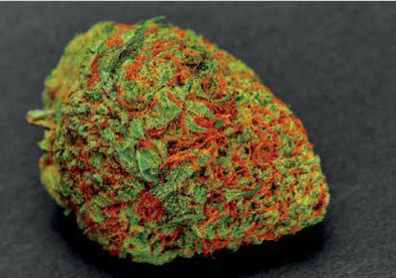
A predominately male flower with some female parts. GBD/DAZ MEPHISTO.
ONE OF THE great things about growing tomatoes as a hobby is the ability to get as deep into it as you want. It just depends on what you want out of your hobby. So too with Autoflowering Cannabis.
There is a complete spectrum of activity intensity from plunking seed into soil and walking away, satisfied with only a small harvest, to developing your own heirloom seeds or clones and going for maximum yields and strength. Autoflowering Cannabis plants are great hobby plants.
The choice is obviously yours. However, even if you decide you are not interested in this more advanced aspect of growing Autoflowering Cannabis, it is a good idea to know how your Autoflowering Cannabis plants came to be. You might later decide this is an aspect of gardening with Autoflowering Cannabis that you actually would enjoy.
With tomatoes, breeding is pretty easy. You choose open-pollinated fruits with the best taste or size or take seed from plants that resist mildew and repeat season after season until you are satisfied. Sometimes you might paint a bit of pollen from one flower to another and come up with an interesting cross. It is pretty easy.
Autoflowering Cannabis plants don’t have the same kind of flowers as do tomatoes. Tomatoes have one flower that has both the male and female parts. Cannabis produces male and female flowers. Crossing them is different.
There are a few new terms you will want to know before you begin breeding Autoflowering Cannabis. As with many things in the Cannabis world, some terms have come to be used in particular ways.
A phenotype is the sum of the traits you see in a plant. In the Auto-flowering Cannabis world, the word phenotype is used to describe a characteristic like height, as in tall or short phenotypes, or bushy and tree-like phenotypes. Some of these characteristics result from genetics, but others are as a result of abiotic (environmental) influences such as sunlight or temperature.
Some varieties are not stable, and so the same plants grown in the same area may be totally different phenotypes. They display different traits even though they are of the same variety. These seeds are unpredictable.
The job of the breeder is to select traits and breed them into (or out of) what will hopefully become a new wanted strain of Auto-flowering Cannabis that is stable. This is usually accomplished by exploring traits of various available stock.
Discovering new phenotypes with new traits can be accomplished by “crossing” two plants and then crossing the offspring with each other and seeing what appears. Or you may want to keep the trait the first cross created. This is what makes the hobby so interesting. There are so many possible outcomes.
Performing a backcross consists of breeding one of the new off-spring with one of the parent plants. It stands to reason that when you perform a backcross, you end up increasing the chances the next generation will have traits like the original plant. This is because there is more genetic material identical to that of the original plant. And, it turns out, with Cannabis you only need to do a backcross once or twice to see results.
Of course, once you have a plant with the traits you want, you have to make sure it is stable. This can usually be accomplished by backcrossing again, one more time. This isn’t as much difficult as it is time-consuming. In addition, you might not find what you are looking for or you could lose it altogether. This is why breeding Autoflowering Cannabis is an interesting hobby.
There are lots and lots of books on genetics, and some, no doubt, were written with Cannabis in mind. The subject is lightly (very lightly) covered here as it is a good idea to have a picture in your mind of how Autoflowering Cannabis varieties come to be.
First, Autoflowering Cannabis is a diploid plant. This just means it gets its genes from its mother and from its father. Some genes are dominant, and some are recessive and hide in the background. Depending on the parents, different traits manifest themselves.
Since we are dealing with Autoflowering Cannabis, autoflowering is an important trait. By way of an extremely simple example, let’s make a plant with a dominant photoperiod (P) trait and a non-photo-period recessive trait (r).
Let’s assume that the father plant has two of the P traits in its genetics, PP. The mother has two r or non-photoperiod traits, rr. (These pairs are considered homozygous for those who do crossword puzzles.)
Now, cross these homozygous plants. The father can only give a P gene to offspring. Likewise, the mother can only give an r. Thus, the offspring have one trait carrier from each parent, represented as either Pr or rP.
The fact that these first-generation crosses have two different traits makes them (in breeder speak) F1 hybrids because they are the first of the new generation made from a cross. However, if both the parents are PP, the offspring will also be PP. This is known as breeding true or true breeding.
Let’s run through the possible combinations when we cross a hybrid pair, Pr with Pr. The possible combinations of offspring are PP, Pr, rP, and rr. Only the PP will be a true breeder, always creating an autoflowering offspring. The Pr and rP are hybrids that will be auto-flowering because of the dominant P. Finally, the rr will be dependent on a photoperiod.
This is basic Mendelian genetics. It is not complicated, but unfortunately, while it is useful for explanations, it is not accurate. Traits are carried on DNA, and there is nothing singular about them as Mendel thought (and most of us were taught).
A few things become obvious. For example, crossing a true Auto-flowering Cannabis with another true Autoflowering plant is easiest. In fact, it is very easy from a genetic standpoint. The day-neutral gene is recessive, but in both parents, so the possibilities of getting an rr, to keep to the simplified example, are greater.
Mixing an Autoflowering Cannabis with a photoperiod plant is much more difficult because the day-neutral gene is recessive. Not very many, if any, of the F1 generation from such a mix will have day-neutral traits. Statistically, the next generation will have 25% day-neutral plants, however.
Since it takes a couple of months to grow plants, you can see how breeding for a stable plant takes time. In fact, if you are lucky and all things go right, you are going to have to grow up to 6 or 7 generations before you can know your phenotype is stable and be certain that it will stay that way.
This is all a bit of work. This doesn’t mean you cannot use the harvests from your female crosses if you want. And, you are not dealing with the longer growth period of regular Cannabis. It is even probably quicker to develop your own variety of Autoflowering Cannabis than your own heirloom tomato.
Sometimes when you cross two plants, you get a plant that does exceptionally well. This F1 hybrid is said to have hybrid vigor. If you happen to have an F1 cross that performs just as you want it, then you preserve it by recreating its lineage, not by crossing it with itself or its parent.
You should be familiar with this concept as a tomato grower. Open-pollinated seeds you can cross and recross with other open pollinated seeds. Try to breed an F1 hybrid with the same F1 hybrid, and you will not be able to maintain the so-called hybrid vigor.
The way around this is to keep a line of the parent plants going. This way you can continually recreate the cross. This is how it is done for many home garden and agricultural seeds (especially corn). It is easy to see why there is a need for professional breeders.

A predominately male flower with some female parts. GBD/DAZ MEPHISTO.
Just a bit more before you know enough to start breeding (or decide to skip it and just buy seed). First, you need to choose a female partner that has the flower traits you want. This is easy as you almost always see these traits expressed because the female has flowers.
What contribution a male plant can bring to the table is a whole other matter. It is only by experimentation that you can figure out what a male plant is contributing. Once you find one capable of passing on desirable traits, you may want to stick with it for a while. It can be a time-consuming and frustrating process to cross male plants with female plants looking for desirable male traits to be passed on.
You will be pollinating one female plant with pollen from a male plant. There is some argument about pollinating feminized seed-grown females. Doing so increases the potential of getting plants that produce male and female. Just be aware. You will have to use what you have to use!
It makes sense to buy female seeds because it takes the guesswork out of growing plants that will actually develop useable buds (which males won’t). Buying is also easier than creating your own feminized seeds, accomplished by forcing the female plant to produce pollen sacs.
The feminization process is started by spraying plants with colloidal silver or a growth hormone, gibberellic acid. Both of these chemicals induce female plants to produce pollen sacs at bud sites. (Untreated buds will develop into flowers, and you will see the difference.) After two weeks or so of forming, the pollen sac will swell and start to open. Keep spraying the flower up until this point.
The sac, or the leaf protecting it, will next start to open. This is when you want to collect the pollen. Too early and you may find an empty sac. (This would be a shame after all your work.) Once filled, collect the sacs with a tweezer and put them in a baggie. Shake it and the pollen will fall from the sacs. Then you collect the pollen.
Use this pollen to fertilize a female flower that is a week or so old. Obviously, this won’t be from the original plant from which the seeds were developed, and this is just fine. You will be increasing genetic diversity whereas normally the plant would self-pollinate.
After a few more weeks, the fertilized calyxes will break open as seeds pop out. Congratulations. You can now plant these seeds and see what you have developed.
Fortunately, there are more and more breeders selling seeds of Autoflowering Cannabis, primarily through dispensaries, but also via the Internet in places where it is legal to ship them at this point in time. Since all of these started with the same breeding stock, it is not unusual to find crosses with the major Cannabis indica and Cannabis sativa strains.
If you are entering a breeding program, you can use already developed Autoflowering stock for your crosses, or you can use the bigger cousin plants to breed with a particular Autoflowering Cannabis that is of interest to you.

Landrace Cannabis growing at the base of Mt. Dhaulagiri, near the village of Kalopani, Nepal. Isolated for centuries, landraces make for great genetics. AME HUNKELHEIM, WIKICOMMONS.
A landrace, or landrace variety, is a particular strain of any plant that has been developed in one specific area of the world over a period of a hundred years or more. They have always been great for breeding purposes because, having gone generation after generation without crossing with other strains, their genetics, and thus their traits, are extremely stable and don’t vary among plants. They are almost invariably 100 percent sativa or indica.
With the exception of landraces, all of the thousands of varieties that are available today have been breed for special characteristics—mostly related to prohibition! There is nothing wrong with this, but for example, parents that required long growing seasons were then bred for shorter growing season length.
With legalization, plants don’t have to be hidden and information about genetics can be openly exchanged. Many of the earlier desired traits no longer matter. Now breeders are going back to landraces to look for genetics from these original varieties.
These special varieties are the basis of many breeding programs. This is important because when you see the name of a country or a region in the name of a Cannabis strain, it is most likely a landrace (or a very close descendant of one).
Famous landraces such as Acapulco Gold and Panama Red are well-known sativas. Perhaps the best-known landrace indica is Hindu Kush. These and other landrace strains are covered in the next chapter.
One of the goals of a breeding program is often to achieve various colors in the plants. Some flavonoids are yellow. Anthocyanins are red flavonoids. There are a few hundred of these pigment molecules that impart a range of blue to purple colors. Developing these is one of the goals you might want to incorporate into your own breeding program.
Tom put a few Autoflowers outdoors by a swimming pool, and they were stunning. Sure enough, these plants are quite the conversation starters. In Alaska, where we have cooler evenings, I have had plants turn a lovely purple color that only enhanced their uniqueness and delicate beauty.
More and more breeders like New Breed Seed and Mephisto are working on developing colorful plants—both flowers and leaves. Recently, I saw a plant grown from Australian seed that didn’t even look like a Cannabis and, while only 10 inches tall, had hundreds of nodes. Now that prohibition is over, there will be no stopping progress!
There is an amazing array of colors to choose from to start a breeding program, since colorful photoperiod Cannabis flowers are great sellers in dispensaries, and commercial breeders have hunted for, and incorporated, all the colors of the rainbow. When you grow a plant with blue, yellow, purple, and pink hues, some of which scream with psychedelic overtones, you have really reached a peak in this hobby. You may not want to use it after you harvest it, as it is so pretty!
Autoflowering Cannabis can act like maple trees that turn color. Cool temperatures result in the stronger chlorophyll pigment breaking down and the background colors appear. Breeding stock for this kind of color change includes such famous Cannabis varieties as Fruity Pebbles, Black Tuna, and Pink Flower Shaman.



The colors available for breeding are truly stunning. ADOBESTOCKPHOTOS.
There are really two ways to get colorful plants. The first is to grow at least the maturing stages in cool conditions. Outdoors you are at the mercy of the climate, but indoors, it doesn’t take much to provide, especially for the smaller Autoflowers, a cool environment.
Of course, achieving a cross with fantastic color may not result in a cross you want in terms of its cannabinoid content, or its flavonoids for that matter. Still, some growers won’t care, just as they really don’t care if that chocolate or plum tomato tastes good, just as long as it looks great.
Red and pink—Red and pink hues can be found when the pistils of some strains turn purple. Often this is caused by a lack of phosphorus, so be careful. (This is not how you want to gain the desired color.) In some varieties, it is the leaves that turn into the red zone. This is usually driven by genetics and not weather. Try any of the “Pink” named phenotypes such as Pink Lady Kush, Pink Lemonade, or Pink Flower Shaman.
Yellow hues—Yellow colors are caused by carotenoids and flavonoids just like in vegetables and fruits. The flowers display the color. They are induced by cold temperatures, too, when the green chlorophyll fades, but also by alkaline conditions.
Alien OG, Grapefruit, Lemon Kush (Lemon! How appropriate), Kandy, Skunk, and Wicked OG can display yellows. Yellow varieties often have gold as part of their names. (Acapulco Gold, anyone?)
Black hues—Black is not really the color displayed, but it is the right term for what is a whole range of dark flower colors that are close to black. If the genetics are there, cold (10°C, 50°F) temperatures can induce leaves to show a dark color (but that is very cool, at least for the vegetative stage).
There are some strains that don’t require weather to display color. These phenotypes often have black in their names: Black Diesel, Black Mamba, Black Willy, Black Widow, Black Tuna, and a landrace, Vietnamese Black. Violetta and Malawi can be used as well. These have dark purple leaves by the time of harvest.
Obviously, one might want to develop a high THC producing strain. This is the major cannabinoid that is measured by labs, as it has been (wrongly) assumed to be the only thing that controls the plant’s psychoactivity. Look for numbers of 20% THC or higher.
Current high (sorry) percentages for THC have just started to reach over 30% of the plant’s resin, as of this printing. This is a great increase over earlier years and are a direct result of breeding programs.
CBD does not produce a psychoactive response, as you now know. It impacts the body but not the brain. It is in great demand by those who want some of the plant’s medical benefits, however. During prohibition days, no one paid much attention to CBD, so there wasn’t much effort to increase its numbers. Things have changed. Now there are 100 % CBD strains, even in the Autoflowering arena.
If you grow your own seed, you are going to end up with more seeds than you can possibly plant. This is both because these little plants can produce a lot of seed when you let them, but also because you are probably limited in how many plants you are allowed to grow, unless you are a licensed commercial or caregiver grower. Store excess seeds in an airtight container in a dark, cool spot or give them away!
Fortunately, Cannabis seeds can be stored for 5 or 6 years before they begin to deteriorate. Light, temperature, and moisture are key things to control. You also need to protect your seeds from pests like rodents and birds (Cannabis seed, in the form of hemp, is in bird feed mixes), as well as from ethylene exposure.
You will need a glass container for storage. These do not leak. Plastic baggies are not the way to go as they often are not airtight and deteriorate. (Especially in the presence of piney-smelling Auto-flowering Cannabis, right?) Do not forget to label your jar.
It is imperative that seed goes into storage dry and remains dry. To ensure this, you will need to end up with seeds that have about 2 to 4 percent water. Use a desiccant pack to absorb the moisture in the jar and hold it. These have the added advantage of absorbing the small amounts of ethylene given off by the seeds, which has a deleterious effect on them.
Some freeze seeds to store them, but that is not a suggestion I support. Instead, a cold room, a basement, a crawl space, or a garage will do. You can use the refrigerator, of course, and this may be the easiest, but you have to worry about fluctuations in temperature. (Place your jars way in the back and don’t open the door so much!) A dedicated refrigerator may be called for, depending on how deep you get into breeding. (However, even leftover seeds from a packet should be stored properly.)
It is light, temperature, and humidity fluctuations that should be avoided. This is why it might make sense to keep your seeds in a jar in a dark room that maintains temperature, instead of a refrigerator that is in constant use. It is up to you.
Traditionally, cloning (simply growing a plant from cuttings) has not been a method for reproducing Autoflowering Cannabis. One reason for this has to do with the size of the early Autoflowering Cannabis plants. These were originally really small, about 12 inches. It was, frankly, pretty hard to take a viable cutting which would have enough nodes to work with.
In addition, Autoflowering Cannabis plants simply grow too fast for cuttings to root and develop a worthwhile number of flowers. Super Autoflowering Cannabis plants may have long enough branches and take longer to grow. If you want to try cloning, use these and take cuttings early.
The best time to take a cutting to use as a clone is around the 3rd week. As you now know, for many Autoflowers, this is simply too late. Flowers will have appeared. You are really wasting your time if a clone is taken too long after the first white pistils appear.
If you do decide to try and clone, take your cuttings carefully. You want to use a sharp razor blade and cut one of the very lowest branches close to the main stem. Ideally, it should have three nodes, but you might get away with two. Remove leaves starting to grow from the bottom node of the cutting, split the stem from the bottom up 1/2 inch (give or take, depending on what you have to work with). Use a sterilized razor blade or sharp knife.
Then dip the cutting into rooting hormone, which you can get at nurseries and grow stores. Place the cutting into a small container of potting soil. Cover it with a plastic bag or similar material to make a tent, keeping in the humidity.
The clone should root in a week. It will probably be going into flower, but it will grow and develop buds. These may be a big “meh,” or they may even surpass those of the mother plant. And, since this is not the normal way to reproduce your plants (although it is fun), when it works you get bragging rights in the Autoflowering Cannabis community and with your fellow home gardeners.
Breeding Autoflowering Cannabis plants is not difficult, but it does take time and so it takes patience. There are a few rules to keep in mind, and the very first is not to skimp on genetics. You should use high-quality seed to begin with. This probably means pre-feminized seeds are the only way to go, unless you are looking to produce pollen from a male plant or expand your skills in growing by getting into feminization of your own seeds.
Find seed from breeders you can trust. Seed packets should contain a lot of information and a picture, or should direct you to a website that contains information. The genetics of the strain should be listed so you can look up the variety and know what you are working with. Don’t buy unless you really understand what you are getting.
If nothing else, learn to appreciate those commercial breeders who work to keep happy all those who are not interested in producing their own seeds.